
- •Stahara publishing company
- •Lesson 1.
- •Instead of trying to free your wrists by the strength of your arms, you force them out by the strength of the abdomen and the weight of the body.
- •Instead of memorizing this as an abstract principle, visualize it in the concrete instance of the simple trick exemplified on the preceding page.
- •Ichi II-gatashi.
- •Lesson 2.
- •In fact, in a five minutes bout in jujitsu each will have made the other quit several times and they will always keep smiling.
- •Lesson 3.
- •Lesson 4.
- •Lesson 5.
- •Lesson 7.
- •In short, they wanted to train, not only the muscular endurance of the soldier, but his morale, or fighting spirit.
- •Lesson 8.
- •Lesson 9.
- •Lesson 10.
- •Lesson 11.
- •In practice put strength into the blow but stop it a few inches from his neck. With this blow it is an easy matter to knock a man out.
- •Lesson 12.
- •Lesson 13.
- •Summary
- •Lesson 14.
- •Seized from behind -- Fig. 82
- •Lesson 15.
- •Lesson 16.
- •In practice exert only sufficient pressure to force opponent to give the signal of defeat.
- •Lesson 19.
- •Lesson 20.
- •Lesson 21.
- •Lesson 22.
- •Lesson 23.
- •Lesson 24.
- •In teaching men who were going to the war, all the training was directed towards making them kick or hit a vital spot rather than try for a hold.
- •It seems that the burglar threatened him by brandishing a two-handed, razor-edged Japanese sword over his head, and demanded his money.
- •Lesson 25.
- •Lesson 26.
- •Lesson 27.
- •Lesson 28.
- •Lesson 29.
- •Lesson 30.
- •Lesson 31.
- •In practice, do this so slowly that there is no danger of injuring your opponent's elbow. He will stand still and let you experiment, and you must allow him the same privilege.
- •Lesson 32.
- •Lesson 33.
- •Lesson 34.
- •Lesson 35.
- •Lesson 36.
- •In practice do it slowly and release him the instant he quits.
- •Lesson 37.
- •Lesson 38.
- •Lesson 39.
- •Verbum sap: a word to the wise is sufficient
- •Lesson 42.
- •Lesson 43.
- •Lesson 44.
- •Lesson 47.
- •Lesson 48.
- •It is not recommended as a practical fighting trick, as it leaves you open to a kick just before it is secured.
- •Lesson 51.
- •Lesson 52.
- •Lesson 53.
- •If you start too roughly at first with one another, you will never continue your practice to the point of proficiency. Advanced practice in throwing man from behind
- •Lesson 54.
- •Lesson 55.
- •Lesson 56.
- •If the escape be executed before Assailant gets his full pressure on your neck, it is easy to get away.
- •Lesson 57.
- •If you do it gently, not only is there no danger, but no discomfort.
- •Lesson 58.
- •Lesson 59.
- •If you are on patrol duty and see an enemy ahead of you whom you must "get" without letting him give the alarm, steal up silently and get him unawares.
- •Lesson 60.
- •Lesson 62.
- •In practice, be gentle. In actual attack knock him out, or at least render him speechless, by a sharp blow on the windpipe with the wrist.
- •The scope of this course
- •"It isn’t whether we win or lose, but how we play the game."
Lesson 22.
This lesson teaches you: --
Escape from the elbow break.
Prevention of escape.
Wrong method of elbow break.
ESCAPE FROM ELBOW BREAK
As Assailant slowly presses you down with the elbow break, slowly twist your body to the left, thus releasing your elbow and lowering your right hand..
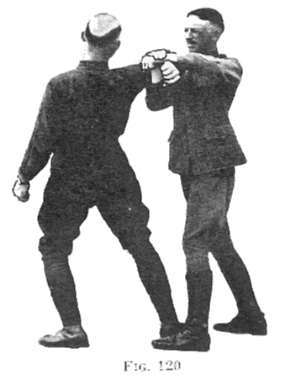
It will then be easy for you to twist around, release your right hand, and give your opponent the elbow blow in the solar plexus with your left arm.
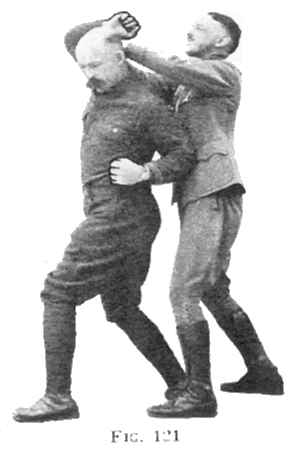
(The instructions are so worded that the veriest tyro will have no difficulty in doing the trick correctly and without danger.) PREVENTION OF ESCAPE
Frustrate opponent's efforts to escape by pressing with your left forearm and pulling with your right forearm.
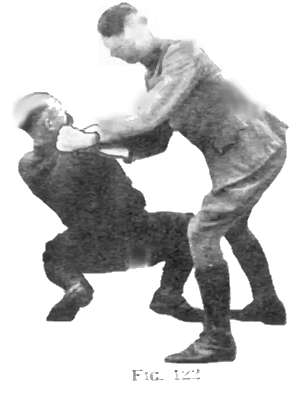
A little experimenting will show just how it is done.
In this practice, be cautious. Go slow.
By continuing the pressure on his elbow it is easy to force him to the ground. It is superfluous to trip him.
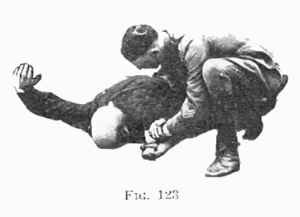
In case of necessity, it is easy to break his arm or to hold him prisoner. WRONG ELBOW LOCK
Some instructors teach you to block your Assailant's arm with your own right forearm.
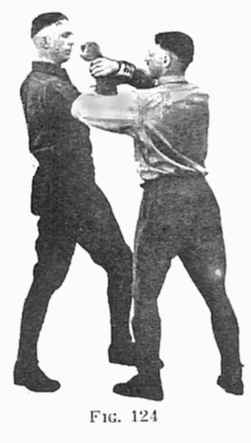
Pass your left hand behind his forearm and grasp your right wrist.
Force his hand back until he quits.
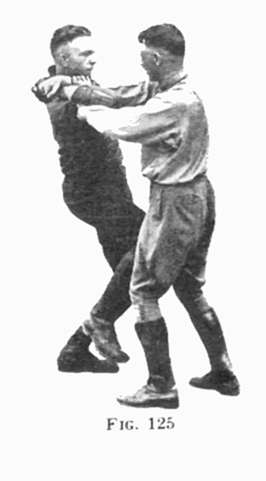
THE COUNTER
The counter to this trick is obvious and easy.
Simply bend one knee, dropping down, thus relieving the pain in your elbow.
Raise the other knee, and kick him in the stomach.
Lesson 23.
This lesson teaches you: --
The second defense against downward blow of knife.
It also teaches you the principle of the line of support.
SECOND DEFENSE AGAINST DOWNWARD BLOW OF KNIFE
Assailant may frustrate your attempt to secure the elbow break by straightening his arm.
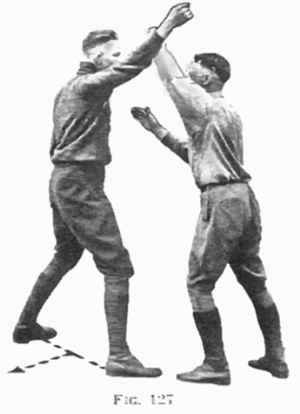
Immediately give up the idea of trying for the elbow break and instead, force his arm straight up and back.
Catch him on the throat with the space between the thumb and forefinger, of your right hand, pushing him back at right angles to his line of support.
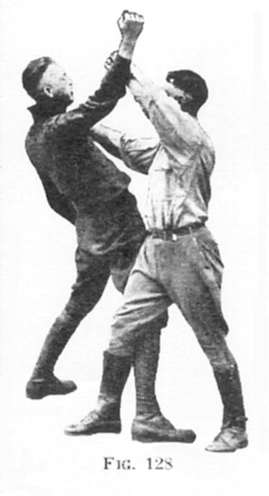
This shows a trip by bringing your right leg behind his right leg. This can only be done when his right leg is forward.
It is superfluous, as if you strike him smartly on the neck, in the proper direction, he will go down like a ninepin.
If you are ever up against a man with a knife, the most important thing for you if you wish to survive, is to give him your knee, either before or after your hand has reached his throat.
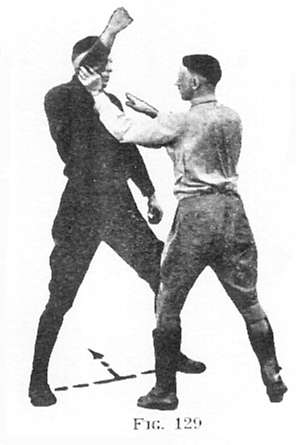
Assailant again attacks you with his right arm stiff and straight making the elbow break impossible.
Again force his right arm up unbalancing him backwards.
He has stepped forward with his left foot this time making it impossible to trip his right leg as on previous page.
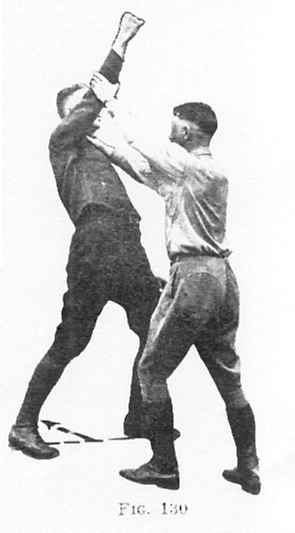
A trip is unnecessary as a blow to the throat with the right hand will knock him over backwards.
The direction of the blow must be at right angles to his line of support.
This demonstrates that the trip shown on previous page is unnecessary. You can throw your man in both cases much more quickly by the blow on the throat.
In practice simply unbalance him slightly until you feel that you could throw him with a little extra shove. THE LINE OF SUPPORT
The line of support is a line drawn between your feet.
If the pressure you exert against opponent runs in the same direction as his line of support you are working against his strongest point.
To illustrate, when opponent has right leg forward, if you push against his left leg, you are working against his strongest point.
If his left leg is forward and you push against his right leg, you are fighting 100% of his strength.
Instead of that, if you work at right angles to his line of support, as illustrated in figures 128 and 130, you can always throw him, if you work neatly.
If on the other hand you work clumsily and allow him to divine your intention, he can change his line of support and bring it parallel to the direction of your pressure, and thus frustrate your intentions.
This principle I submit as the solution of the enigma propounded in the terse observation (credited alike to Bob Fitzsimmons, of cherished memory, and the more humble disciples of the cult of jujitsu), "The bigger they are, the harder they fall."
It also supplies the clue to the broader principles of jujitsu on which the statesmen, financiers, and economists, both of the Orient and Occident, base their diplomatic relations with each other.
No teacher at whose feet I have sat, or whose writings I have earnestly studied, has ever informed me of this principle.
I have had to find it out for myself, and I therefore submit it, I hope with pardonable pride, as my own discovery.
However, history relates that when Columbus showed a critical world how to stand an egg on its end, he was told that he arrogated too much credit to himself.
Similarly I may be told that my labored explanation is superfluous, and that I have simply stated a well-known principle of applied mechanics.
If that is so, I shall not press my point, but instead shall express pleasure and gratification that the principle is so thoroughly understood.
Will the kind reader retrace his steps to Book 4, and apply this principle to his execution of the back throw.
He may then review all the other lessons in this course, and apply this principle to every trick in which he should unbalance his opponent.
He may perhaps be generously inclined and admit that I have discovered a new principle in the applied mechanics of hand-to-hand fighting.
If so, I thank him sincerely.
If not, I shall simply remark that it is a hard world, and pass on to the next lesson.
